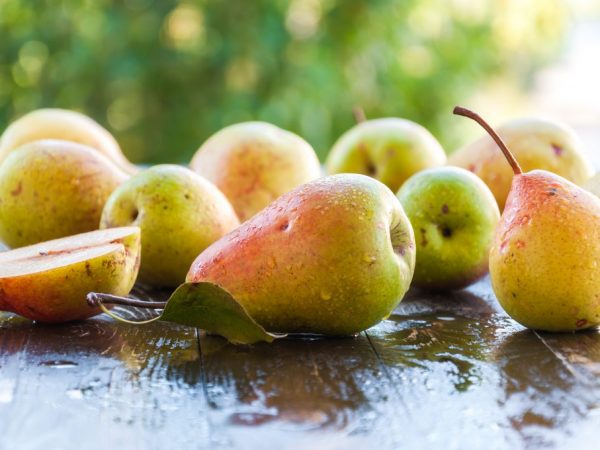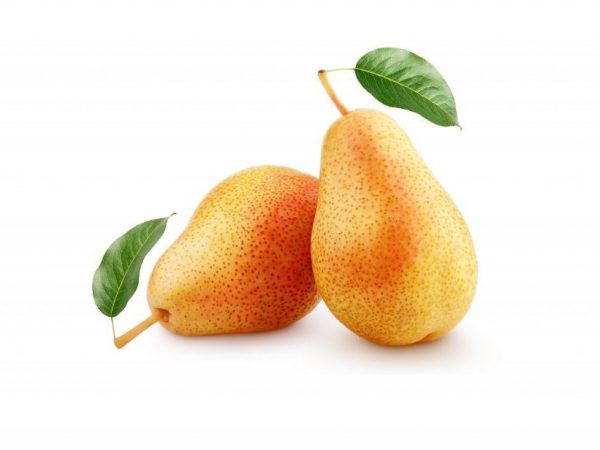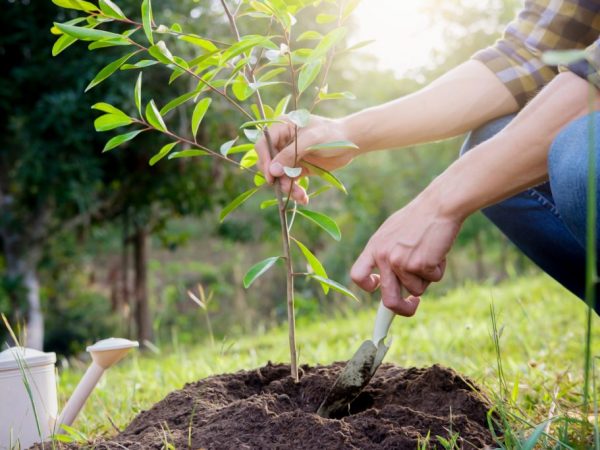Description of pear Trout
Pear Trout traces its history through decades, it is widely grown in China, the USA and Latin America. Today, its fruits are considered the most beautiful and fragrant, and the variety does not lose its popularity at all. A detailed description of the Trout pear variety is presented in the article.

Description of pear Trout
Variety characteristic
Pear Trout belongs to winter varieties, is not self-fertile. It is distinguished by a fairly early flowering (end of April), the fruits begin to ripen closer to mid-September. The first harvest from young trees can be obtained already in the fourth year of their growth.
In our region, it is grown quite rarely due to the fact that the seedlings take a long time and take root, and the established plants are often exposed to diseases. If you manage to grow a healthy tree, then it will delight you with high yields and delicious fruit qualities.
It should be noted that Trout pears have excellent transportability; in suitable conditions, they can be stored for a long time. They are used for baking, various desserts and as decorations, as well as canned.
Description of the plant
A medium sized tree is ideal even for small areas. It rarely grows above 5.5 meters. The color of the trunk is dark brown, branches and young shoots are lighter, with a grayish tinge.
The crown is spreading, small leaves are painted in a deep green color. The beautiful shiny surface of the leaves, their smooth edge and expressive yellow veins are one of the distinctive features of the Trout pear variety.
The bloom is profuse and fragrant. This attracts well insects that pollinate the plant.
Description of fruits
Small fruits weighing no more than 150 grams. They have a slightly elongated, regular and very neat shape. Fruits are yellow-orange with red dots.
The pulp is white with a light creamy shade. Very soft, but juicy and sweet in taste, vaguely resembles cinnamon.

Fruits are yellow-orange with red dots.
Benefits
The benefits include:
- excellent taste of fruits;
- high productivity;
- versatility of fruit use;
- high transportability and long shelf life;
- good presentation;
- the benefits of fresh fruits, the high content of vitamins in them.
Planting and growing
In order for the plant to successfully take root and give good yields in the future, it is necessary to carefully choose the seedlings. Its branches should be safe and sound, and the root should be 60-80 centimeters long. The seedlings should not be more than two years old.
It is best to plant trees in spring, when the ground has already warmed up to 13-15 degrees, or in early autumn. It is worth choosing places with a lot of sunlight, away from large trees that can provide shade.
Before planting, it is recommended to hold the seedlings in a cool place, and treat their roots with a solution of potassium permanganate. Provided that it is planted in the spring, it is recommended to prepare the pit in the fall.Its size is about 80 centimeters in diameter and a meter in depth.
Drainage is lowered to the bottom of the pit, sprinkled with soil, then a seedling is lowered into the pit, spreading the roots. Next, the plant is covered with a fertile composition by two-thirds and watered with water, after which the soil is again put. It is important to ensure that the neck of the tree remains on the surface.

For a good harvest, you need to carefully look after the pear Trout
Care
Pear Trout needs constant care, especially at a young age. The first time after planting, they must be watered with exceptionally warm water at least once a week, or even more often. Watering should be abundant.
The description of the variety suggests that it is necessary to regularly loosen the soil around the plant and remove weeds. This improves air flow to the root system of the tree and also helps keep the plant free from pests. The first few years after planting, with the onset of cold weather, trees must be covered.
Humus and manure can be used as top dressings, which are recommended to be introduced only from the second year. Mineral fertilizers, as well as potash and phosphorus fertilizers are well suited. An exception is fertilizing containing nitrogen, since they have a bad effect on the quality of the fruit.
Diseases and pests
Plants are prone to attack by various diseases. The most common are:
- black cancer (branches, leaves and trunk are covered with brown spots);
- fruit rot (dark brown spots on the fruit);
- scab (fungal disease on leaves after rains);
- bacterial burns.
The main enemy of plants among insect pests is aphids.
In order to preserve trees and reap a good harvest, it is necessary to carry out preventive procedures that protect against diseases. These include whitewashing of trunks, and a weak solution of Bordeaux liquid, and spraying with a solution of potassium permanganate. You can also use special store products.
Conclusion
Despite their whimsicality, Trout pears do not lose their popularity. If you provide the plant with proper care, it will reward you with a bountiful harvest of delicious fruits.


